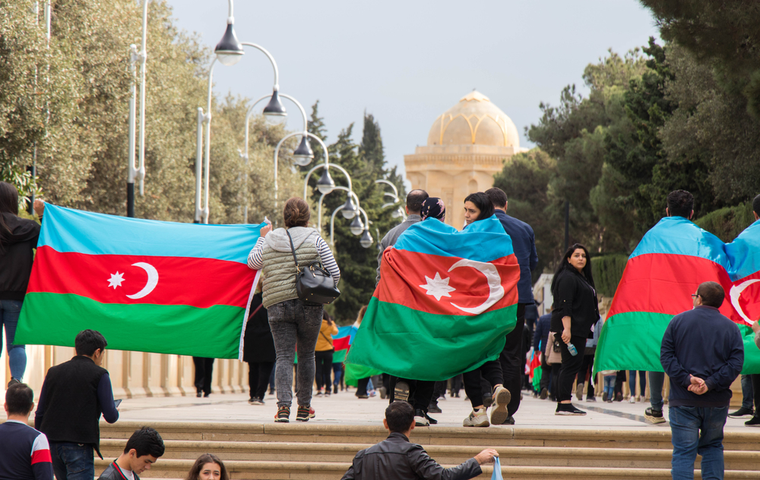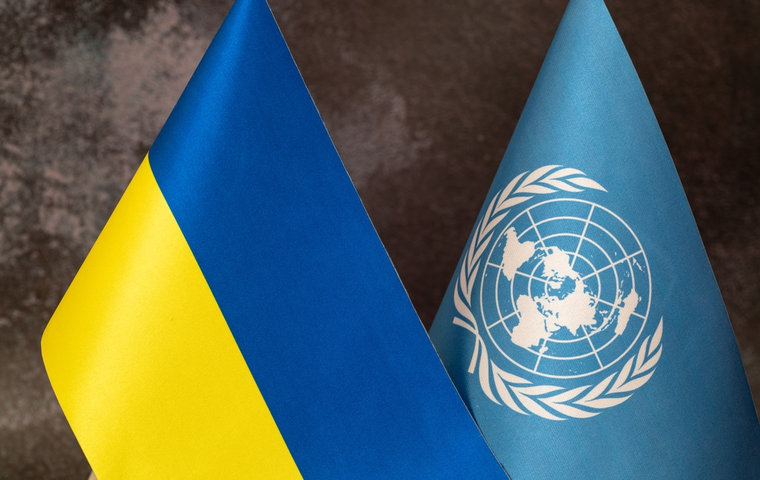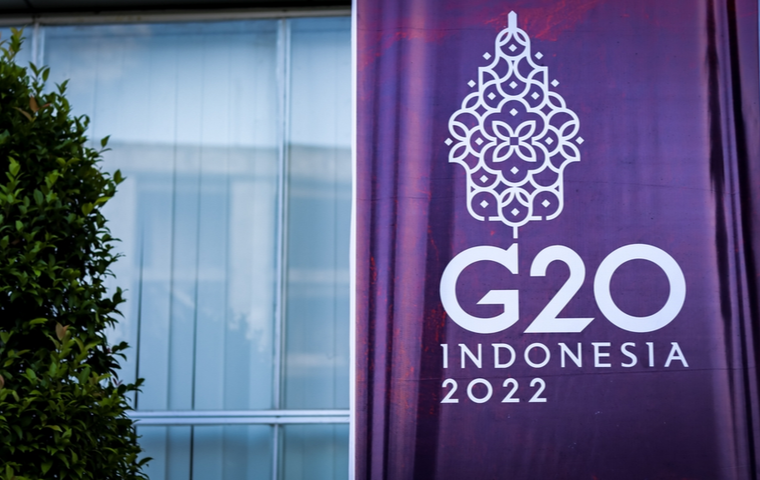Secessionist Conflicts in the Former Soviet Bloc: The Failure to Find the Solution
Related Articles

The international community has searched for a solution to the secessionist conflicts in the former Soviet bloc that would respect both national self-determination and the existing national borders. The balance was difficult to accomplish, and its inability to find the solution to the conflicts as those in Karabakh, Abkhazia, South Ossetia, and Transnistria, has contributed to the Ukraine crisis.
Russian President Vladimir Putin’s assertion of protecting the two Donbas republics as a pretext for invading Ukraine has once again highlighted the dangers of what happens when the international community ignores the secessionist conflicts. The two Donbas republics—the Donetsk and Lugansk People’s Republics—had declared their secessions from Ukraine in response to Ukraine’s 2014 Euromaidan revolution.
There were two waves of secessionist conflicts in the former Soviet Union. The first wave came at the end of the Soviet Union when the autonomous entities (autonomous republics and oblasts) started the breakaway movements from the union republics to which they belonged. The conflicts in Karabakh, Abkhazia, South Ossetia, and Transnistria even led to wars. The second wave came in the form of a rebellion against Ukraine’s Euromaidan revolution in 2014. The annexation of Crimea to Russia can also be broadly defined as a secessionist conflict.
The aim of the secessionist movement at the end of the Soviet Union was not to seek independence from the Soviet Union. The entities sought to separate themselves from their parent republics, such as the Azerbaijan, Georgian, and Moldovan SSR. As the parent republics intensified their inclinations to secede from the Soviet Union, the entities in essence said, “do as you please, but we want to stay in the Soviet Union.”
In other words, the essence of these movements was that the entities were trying to remain in the Soviet Union. Since the Soviet Union suddenly disappeared, these former autonomous entities were orphaned, meaning they become unrecognized countries.
Inviolability of Borders or the Right to Self-Determination?
In recognition of the mistakes made in World War II, Westphalianism became dominant in the international community. This meant it privileged existing sovereign states and was extremely wary of changes in borders and the birth of new states.
This led to the 1975 signing of the Final Act of the Conference on Security and Cooperation in Europe (CSCE) in Helsinki, which established the principle of the inviolability of borders. Since the United Nations is an organization composed only of recognized states, it has a strong tendency to take the side of the parent state when a separation conflict occurs, and therefore lacks the ability to gain the trust of both parties and mediate the conflict. This is where we need a more neutral international organization like the Organization for Security and Cooperation in Europe (OSCE) to intervene.
When multi-ethnic states such as the Habsburg Empire, the Ottoman Empire, the Soviet Union, and Yugoslavia are dissolved, under international law, there are two ways to resolve the issue of what kind of new states should be recognized on the vacant land: the right of self-determination and the uti possidetis juris (newly-formed sovereign states should retain the internal borders of their former states.)
During the interwar period, the push for the rights of self-determination in Eastern Europe caused numerous territorial disputes and allowed the rise of the Nazis. In reflection of this, after WWII, uti possidetis juris became the dominant legal doctrine. This led to the principle that after the dissolution of the Soviet Union and Yugoslavia, only the former union republics (the highest administrative units) would be recognized as newly independent states, and the independence of autonomous republics and autonomous oblasts would not be recognized.
However, compliance with this principle is difficult, as represented in the fact that since 2008, more than ninety countries led by the United States, including Japan, have decided to recognize the independence of Kosovo, which was no more than an autonomous region within the Socialist Republic of Serbia in the former Yugoslavia. Just as advocating the right to self-determination aggravates conflicts, the dogmatic application of uti possidetis juris produces the same results.
Power-Sharing Method or Land-for-Peace?

The United Nations and the OSCE believe that the separatist government should be voluntarily dissolved and reverted to the parent country. They have traditionally advocated a power-sharing solution, with the separatist government voluntarily returning to the parent country in exchange for the federalization of the parent country and territorial autonomy of the breakaway region.
However, in the post-socialist era, the only time this method has managed to resolve a conflict is the revival of Bosnia and Herzegovina through the Dayton Agreement (1995). This confederation is also a fragile one.
In a seemingly unexpected historical parallel, a successful example of the power-sharing formula was seen in the process of the establishment of the Soviet Union. The central government of Soviet Russia confirmed Azerbaijan and Georgian republics’ effective control of disputed territories, such as Karabakh, Abkhazia, and South Ossetia, which they inherited from their preceding (non-communist) states. In exchange, the central government requested Azerbaijan and Georgian republics to grant autonomy to these territories.
But today’s international institutions are not as good at enforcing the power-sharing method as Bolsheviks were in the past. The Bolshevik government was uncompromising and coercive enough to ensure the local governments kept their promises. International institutions cannot do this.
Even if a parent state promises to grant territorial autonomy to a disputed area, there is no guarantee of it keeping its promise. For a secessionist government, it would be unbearable if the promise were broken after it abandoned arms and agreed to voluntary dissolution. This was a commitment problem.
Since the power-sharing formula has not produced results, another formula emerged: the land-for-peace formula in which the secessionist government gives a part of the territory under its effective control to the parent state, in exchange for recognition of independence. Unlike the power-sharing formula, in this case, the borders are changed.
The land-for-peace approach is becoming all the more popular, as seen in the 2004 UN Secretary-General Kofi Annan’s proposal for the Cyprus conflict, the January 2020 Trump administration’s Peace to Prosperity Plan for the Palestinian conflict, and a draft to recognize Kosovo’s independence in exchange for ceding the northern part to Serbia, where the Serbs compose a majority, amidst the escalating conflict in North Kosovo in 2021.
A recent book by Eiki Berg and Shpend Kursani’s De Facto States and Land-for-Peace Agreements: Territory and Recognition at Odds? (London: Routledge, 2022) looks at four conflicts in Palestine, Kosovo, Karabakh, and Northern Cyprus to explore the possibilities of land-for-peace based on research. The authors note many conditions that make land-for-peace difficult to implement and do not merely recommend this policy. They argue that in the face of ongoing conflicts, international organizations and participating states should not dogmatically apply abstract propositions such as protecting the territorial integrity of existing states and the inviolability of their borders but instead seek a solution from a standpoint of attaining a long-term ceasefire with minimum casualties.
The Conditions for Attaining Land-for-Peace
The land-for-peace formula does not work unless there is effectively controlled land that the non-recognized nation can offer to the suzerain state in exchange for recognition of independence. Consider the four separatist conflicts that occurred at the end of the Soviet Union. In the latter half of the Karabakh War (1993-94), the Karabakh armed forces went beyond the former Karabakh Autonomous Oblast and occupied part of Azerbaijan proper that was twice the size of their autonomous region.
As was the case with Abkhazia in 1993 and South Ossetia in 2008, the secessionist conflicts of the former Soviet Union states usually end when the breakaway governments regain their administrative territories during the Soviet era. The breakaway forces would not invade the internal territory of their former parent republic, even if they have favorable military conditions.
The actions of the Karabakh militants, against the opposition of the Armenian leadership, were rule-breakers in the former Soviet Union but gave Karabakh a vast amount of occupied territory that could be offered as a bargaining tool. As a result, since the 1990s, the Karabakh conflict has become a precedent for a land-for-peace solution.
In the case of South Ossetia, it was cleanly divided with ethnic Georgian settlements becoming subordinated to the Georgian government, and ethnic Ossetian settlements becoming subordinated to the South-Ossetian government under the Sochi (Dagomys) Agreement signed in June 1992. Thus, South Ossetia did not have an effective control territory that it could offer as a bargaining tool.
Abkhazia regained its former autonomous republic territory as a result of the Abkhazian War, which included the Gali District (southeast of Abkhazia) inhabited by the Mingrelians, considered a sub-tribe of the Georgian people. Thus, there was a possibility for Abkhazia to offer Gali District to Georgia which could have resulted in a land-for-peace deal.
If Transnistria were to have a land-for-peace deal, it would likely offer the city of Bender, located on the right bank, which belonged to Romania during the interwar period. However, in 2004, more than 60% of the population of the city was of Russian and Ukrainian descent, and the city suffered the most casualties during the military conflict in 1992. Therefore, from the point of view of the legitimacy of the Transnistrian state, it is inconceivable that they would offer it to Moldova.
In summary, there were possibilities for land-for-peace deals in the Karabakh and Abkhaz conflicts.
Avoiding Diplomatic Mistake of Making Protectorates
In the South Ossetian and Abkhazian conflicts, both the former parent republic (Georgia) and the patron state (Russia) tended to put South Ossetia and Abkhazia on the same plate and then carve them. For example, the Georgian delegation suggested to the Russian delegation that Russia “return” Georgia South Ossetia and the Gali District if Georgia agreed with the existence of a pro-Russian independent Abkhazian state in northern and central parts of Abkhazia.
The North Atlantic Treaty Organization (NATO) promised the future NATO memberships of Georgia and Ukraine at the Bucharest Summit in April 2008. The Russian leadership (especially the Ministry of Foreign Affairs) believed that it could dissuade Georgia from joining NATO if it mediated a land-for-peace solution to the territorial dispute. Until around the spring of 2008, diplomacy was clearly developing in Georgia’s favor.
Why Georgian President Mikheil Saakashvili chose to venture a military invasion of South Ossetia in 2008 at such a time has been a subject of dispute among historians. It was the year of the presidential election in the U.S., and the issue had become politicized. Saakashvili was suffering from a falling approval rating at home since his government suppressed a protest at the capital Tbilisi in November of the previous year. These two factors are seen as contributing to the invasion.
After the South Ossetian war in August 2008, the Russian army temporarily occupied Georgian territory (Upper Kartli). Its purpose remains a mystery to historians. According to my interviews, during this brief period of occupation, Russian President Dmitry Medvedev tried to persuade the President of Abkhazia to have the country return to Georgia, by promising to somehow make Georgia accept a proposal for a confederation with Abkhazia. It is presumable that he made the same proposal to the South Ossetian president and failed.
If President Medvedev indeed thought that Abkhazia and South Ossetia would accept the proposal for a confederation with Georgia immediately after harsh hostilities, it would have been unrealistic, but it goes to show how desperate he was to avoid bad diplomacy of recognizing both states and turning them into de facto protectorates. When the Saakashvili government was overthrown in Georgia and the Georgian dream government was established, Russia and Georgia could have rekindled their relationship. However, because Russia had recognized the breakaway states, their hostile relationship was perpetuated.
Regarding the war with Ukraine in 2022, it is difficult to imagine that the Russian government had not considered the option of stopping after recognizing the two republics of Donbas on February 21. However, the government must have allowed adventurism to dominate, as it reasoned that if it approves the two republics, its relationship with Ukraine would be irreparable anyway so it should preemptively go to war.
Could a Military Solution Have Been Avoided?
The Karabakh conflict was not resolved through a land-for-peace approach, despite the fact Karabakh occupied vast territories that could have been traded. The wording of the peace plan gradually increased in complexity from the Lisbon Summit by the OSCE Minsk Group in 1996 to the Madrid Summit in 2007 and then to the updated Madrid Principles.
But the fundamental conflict—that Azerbaijan would never recognize Karabakh’s independence, while Karabakh will never agree to any terms other than independence, was never resolved. Azerbaijan’s perception is that Karabakh is neither a secessionist state nor a non-recognized state, but merely an occupation by Armenia, so recognition of independence is not an option.
Although the stalemate in negotiations itself resulted from the intransigence of the positions of both parties to the conflict, it was the Karabakh-Armenian side that benefited from the status quo. The co-chairs of the OSCE Minsk Group, including Russia, became increasingly frustrated with the Karabakh-Armenian side.
Against the backdrop of the isolationism of the Trump administration, since 2017, the Astana Process (consultations between Russia, Turkey, and Iran) began to regulate the Syrian conflict. As a result, the three conflicts of Syria, Libya, and Karabakh began to move through the credit and liability relationship between the three countries.
The fact that Islamic extremists, who were once on the verge of occupying Damascus, were now contained in Idlib means that Turkey has ceded more to Russia than Russia to Turkey. President Recep Erdogan may begin to request Putin to compensate for this.
However, based on my observations, it is the presidential administration that is extremely appeasing towards Turkey, while the Russian Ministry of Defense, Ministry of Foreign Affairs, and security services are viewing Turkey as a threat, which has been a tradition since the Ottoman era. There would have been much room for Armenian diplomacy to regain Russia’s support, but Nikol Pashinyan, who became the prime minister after the Armenian Velvet Revolution in 2018, was ignorant about diplomacy and the Karabakh issue. This populist government also turned against the Armenian military, which was regarded as closer to the old government, drastically weakening Armenia’s defense capabilities.
The Second Karabakh War in 2020 ended with Armenia-Karabakh’s complete defeat, and Karabakh lost all the occupied territories and two southern districts of the former autonomous region.
In the post-Soviet era, two solutions to secession conflict emerged: division of power (federalization) and land-for-peace. Land-for-peace would have been a more practical method, but this would only work if the separatist government has land it can offer to its parent state. The Karabakh conflict and the Abkhazia-South Ossetia conflict met this condition.
However, even in these conflicts, land-for-peace was not realized, leading to “solutions” such as recognition and protection by patron states (seen in South Ossetia, Abkhazia, the two Donbas two republics) and military conquest by parent states (as seen in the case of Karabakh), that turned a blind eye to future issues. The Transnistrian conflict is the only war that has not repeated itself and has maintained a status quo since the 1990s.
Secessionist conflicts usually involve a fundamental conflict in which the separatist government does not agree to any conditions other than independence, and the parent country does not accept independence at all. This is difficult to resolve. If it takes too long to resolve, the conflict could result in a protectorate state or the military conquest by the parent state, a result that is unfortunate for the international community.
In my opinion, if it is difficult to divorce by mutual agreement, there is no choice but to adopt international judicial methods to mediate the divorce and have the parties comply. Failure to do so will result in more protectorates or military invasions.
This article is a translation of the Japanese original published in the March/April 2022 issue of Gaiko(Diplomacy) magazine.
Kimitaka Matsuzato is a professor at Tokyo University. He received his Ph.D. from Graduate Schools for Law and Politics at Tokyo University in 1996. He is an expert on Russian history and the politics of former Soviet countries. Readers can find his essays in Nationalities Papers, Demokratizatsiya: The Journal of Post-Soviet Democratization, Religion, State and Society, and other journals.




